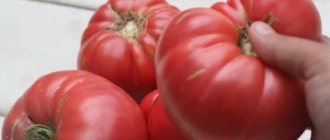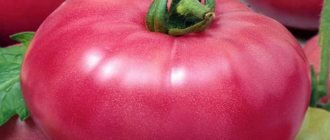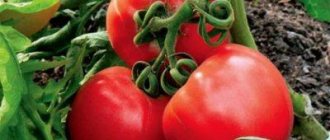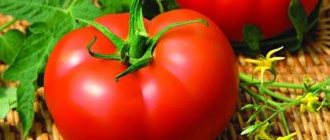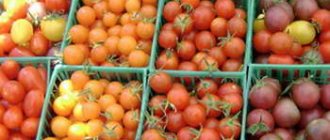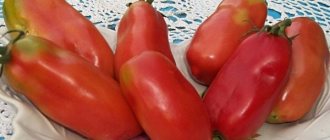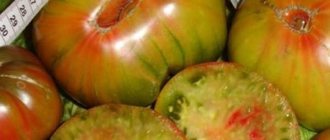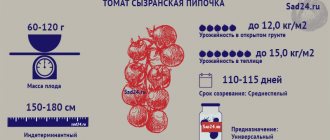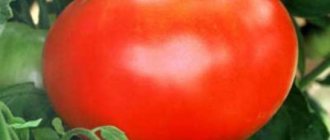The Canopus tomato was named after the famous star. And indeed, in terms of its characteristics, this is a real star - it is very hardy, suitable for Siberia and the arid southern regions, easy to care for, and the fruits have a good taste and aroma.
| Height | Landing location | Ripening time | Fruit color | Fruit size | Origin | Fruit shape |
| short | Open ground | Mid-season | Reds | Large | Variety | Plum-shaped or oval |
Description and characteristics of the variety
The Canopus variety was created by scientists from Siberia at the Institute of Cytology and Genetics. It was included in the State Register in 2000 and is zoned throughout Russia. Tomatoes are also successfully grown in neighboring countries. It is intended for open ground, as it is adapted to all unfavorable conditions: it tolerates cool Siberian summers, temperature changes, and resists diseases.
Typically, cold-tolerant tomatoes do not tolerate heat well, but Canopus is also drought-tolerant.
The variety is low-growing, the bushes reach 50-60 cm. The leaves are ordinary tomato leaves, the branching is average. Fruits appear every 1-2 leaves, starting from the 7-8th leaf. They ripen in 115-120 days after germination, which is considered an average period.
The tomatoes are quite large, 110-180 g each, but with pinching, regulating the number of ovaries and fertilizing, you can get tomatoes up to 400 g. The shape is ovoid or oval, although some fruits (the very first or largest on the bush) can be flat-round. The skin and pulp are red, there are about 4 seed chambers inside. The taste is pleasant, sourish-sweet. Tomatoes are suitable for any culinary use.
Some gardeners find the pulp too sour for fresh consumption, and they prefer to process the tomatoes or add them to dishes.
Advantages and disadvantages
Canopus tomatoes have many positive characteristics. For example, these include:
- high yield (3-5 kg per plant);
- universal fruits;
- good keeping quality and transportability of tomatoes;
- compactness and unpretentiousness of bushes;
- resistance to diseases, pests, droughts and colds;
- simple care for tomatoes.
Plants need sunlight
No obvious shortcomings were noticed, but some gardeners consider the taste of the fruit to be sour. In some cases, insufficient lighting is cited as the cause. To grow sweeter tomatoes, it is recommended to plant them in a well-lit place and thin out the foliage on the bushes in time.
():
Ultraviolet radiation has a great influence on the quantity and quality of tomato fruits. Tomato plants that received the optimal dose of these short wavelengths of light had fruits that were 20% larger and were more aromatic and sweet.
Landing
Seeds are planted in seedlings. The timing of sowing seedlings is 55-60 days before transferring the bushes to the ground. The growing algorithm is as follows:
- Calibrate the seeds (choose the largest and healthiest ones).
- They are checked for germination by throwing them into a glass of water. Those that float on the surface will most likely not emerge.
- Soak in a one percent solution of potassium permanganate for an hour.
- Wash and, if desired, treat with a stimulant - Zircon or Epin (or another drug) according to the instructions.
- The soil is mixed from garden soil, peat, sand and humus, then disinfected with a boiling solution of potassium permanganate or copper sulfate.
- In the soil laid out in large boxes, make grooves 1-1.5 cm deep and place seeds in them at small intervals.
- Cover with soil, moisten and cover with film.
- The first few days before germination are kept in a warm room at +25 or even more.
- After the sprouts appear, remove the film and move it to a sunny place.
- The temperature in the first 3 days is kept at +14, then raised to +18-22.
- They provide a sunny day of at least 8 hours, and if there is a lack of lighting, use fluorescent lamps.
- Picking is carried out in separate peat cups in the 2-leaf phase.
- Before transplanting into the garden, the seedlings are hardened off by taking them outside for a while every day.
If necessary, seedlings can be fed 1-2 times with special fertilizer.
The best predecessors for tomatoes in the garden are zucchini, cucumbers, and pumpkin. It is impossible to plant after nightshade crops.
For 1 sq. m place 4 plants.
Growing and care
In open ground, the variety does not require pinching. They are tied as necessary so that the bushes do not break from the weight of the fruit. In the greenhouse, plants are led into 2 stems and tied.
Although the variety tolerates drought, it benefits from moderate watering. Tomatoes are watered once a week, being careful not to over-moisten the soil and prevent moisture from getting on the leaves and stems. It is better to water in the morning or evening when there is no direct sunlight. The water is slightly heated.
Feed 3-5 times. The following supplements are useful:
- mullein solution 1:10 (about 0.5-1 liter for each bush, but only in the early periods of development);
- solutions of mineral fertilizers (superphosphate, potassium nitrate, potassium sulfate, etc.) according to the instructions;
- special complexes for tomatoes - Kemira, Signor Tomato, etc.;
- spraying the leaves with solutions of boric acid, iodine or mineral fertilizers.
You should not get carried away with fertilizing from manure and bird droppings at the expense of mineral fertilizers. Moderate fertilizing with chemicals is not harmful to tomatoes, but beneficial. Toxic substances do not accumulate in fruits unless overdosed.
Review of semi-determinate tomatoes
Tomatoes of the semi-determinate group, in their characteristics, are something between determinate and indeterminate varieties. The bushes grow up to 1.5 m in height, but can also be low. The crop is characterized by high productivity, versatility in the use of fruits and an open type of cultivation. However, there are semi-determinate tomatoes that bear fruit well in greenhouse conditions. Let's look at the description and photos of some productive tomatoes in this group.
Lilac Lake
The culture is adapted for open and closed cultivation. The slightly spreading bush grows up to 1 m in height outdoors, and 1.5 m in a greenhouse. The stem is secured to a trellis or any support; excess shoots must be removed so that 2 or 3 stems are formed. The vegetable has an unusually beautiful lilac-colored skin with small dots resembling pearls. Inside the pulp is raspberry. Tomatoes grow quite large, weighing up to 350 g. Despite the high density of the pulp, it can crack. The vegetable is considered a salad type.
Serbian heart
The method of growing the variety depends on weather conditions. In the southern regions, growing this tomato in open areas is acceptable; for the middle zone, the greenhouse method is recommended. The stem of the plant extends up to 1.5 m in height. The bush is fixed to the trellis and formed with 2 or 3 stems. Pink, fleshy fruits weigh 250 g. The good taste of the pulp and low seed content have made the tomato popular in salads, as well as freshly squeezed juices.
The video talks about the Serbian Heart variety:
Verna
In the southern regions, the crop yields up to 10 kg of tasty tomatoes per plant. In the middle zone, only greenhouse cultivation is permissible. The mid-season variety has gained great popularity due to the value of the fruit from which baby food is prepared. The vegetable stores well and can be frozen. The stem of the plant extends up to 1.5 m in height. The fruits resemble large plums. The orange vegetable weighs a maximum of 200 g.
Cardinal
The variety will delight you not only with a high yield, but also with large fruits. It is grown in open and closed ways depending on the climatic conditions of the region. The stem of the plant can stretch up to 1.7 m, although it is often limited to a height of 1.2 m. The bushes are fixed to the trellis; the pinching process is aimed at forming the bush with 1 or 2 stems. The shape of the pink tomato resembles a heart. The sweet pulp contains few seeds. The vegetable weighs about 500 g. 5 kg of tomatoes are harvested from 1 plant per season.
Chinese pink
Greenhouse conditions are optimal for growing the crop. Bushes 1.5 m high show good yield results when formed with 2 stems. A pink vegetable in the shape of an even heart weighs up to 350 g. A small number of grains are observed inside the fleshy pulp. Sweet tomato is very tasty in salads.
Summer cider
In terms of ripening time, the tomato belongs to the mid-season varieties. The main stem of the plant reaches 1.5 m in height. The culture is able to adapt and produce good yields in open and closed beds. The bush is formed with 2 or 3 stems, securing it to the trellis as it grows. Large orange spherical fruits weigh 400 g. On the lower tiers of the bush grow giants weighing 800 g. The sweet, fleshy pulp is suitable for dietary nutrition and making salads.
Mom's love
Tomatoes are grown in closed and open beds, but for the middle zone greenhouse growth is desirable. According to the ripening period, the crop is considered mid-season. A bush with a height of 1.5 m is capable of producing the maximum amount of harvest when formed with 2 stems. The plant produces a lot of tomatoes. A ripe vegetable acquires a red flesh color. The tomatoes are large, weighing up to 500 g. There are very few grains inside the sweet pulp.
